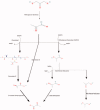The possible role of methylglyoxal metabolism in cancer
- PMID: 34517737
- PMCID: PMC8451662
- DOI: 10.1080/14756366.2021.1972994
The possible role of methylglyoxal metabolism in cancer
Abstract
Tumours reprogram their metabolism to acquire an evolutionary advantage over normal cells. However, not all such metabolic pathways support energy production. An example of these metabolic pathways is the Methylglyoxal (MG) one. This pathway helps maintain the redox state, and it might act as a phosphate sensor that monitors the intracellular phosphate levels. In this work, we discuss the biochemical step of the MG pathway and interrelate it with cancer.
Keywords: Methylglyoxal; cancer; enzyme; pH; redox.
Conflict of interest statement
CT Supuran is Editor-in-Chief of Journal of Enzyme Inhibition and Medicinal Chemistry, and he was not involved in the assessment, peer review or decision-making process of this paper. The authors have no relevant affiliations of financial involvement with any organisation or entity with a financial interest in or financial conflict with the subject matter or materials discussed in the manuscript. This includes employment, consultancies, honoraria, stock ownership or options, expert testimony, grants, or patents received or pending, or royalties.
Figures
References
-
- Jakubczyk K, Dec K, Kałduńska J, et al. . Reactive oxygen species - sources, functions, oxidative damage. Pol Merkur Lekarski 2020;48:124–7. - PubMed
-
- Halliwell B.Antioxidants in human health and disease. Annu Rev Nutr 1996;16:33–50. - PubMed
-
- Hayyan M, Hashim MA, AlNashef IM.. Superoxide ion: generation and chemical implications. Chem Rev 2016;116:3029–85. - PubMed
-
- Verbon EH, Post JA, Boonstra J.. The influence of reactive oxygen species on cell cycle progression in mammalian cells. Gene 2012;511:1–6. - PubMed
-
- Boonstra J, Post JA.. Molecular events associated with reactive oxygen species and cell cycle progression in mammalian cells. Gene 2004;337:1–13. - PubMed
Publication types
MeSH terms
Substances
LinkOut - more resources
Full Text Sources
Medical

